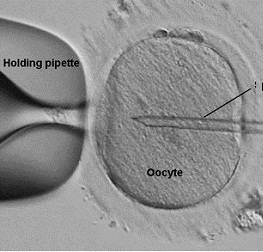- 9975035364
- [email protected]

What is ICSI?
ICSI is an acronym for intracytoplasmic sperm injection.A fancy way of saying "inject sperm into egg". ICSI is a very effective method to fertilize eggs in the IVF lab after they have been aspirated from the femaleIts main use is for significant male infertility cases IVF with ICSI involves the use of specialized micromanipulation tools and equipment and inverted microscopes that enable embryologists to select and pick up individual sperm in a specially designed ICSI needle.The needle is carefully advanced through the outer shell of the egg and the egg membrane - and the sperm is injected into the inner part (cytoplasm) of the egg.This usually results in normal fertilization in about 75-85% of eggs injected with sperm.However, first the woman must be stimulated with medications and have an egg retrieval procedure so we can obtain several eggs for in vitro fertilization and ICSI.
Who should be treated with intracytoplasmic sperm injection?
There is no "standard of care" in this field of medicine regarding which cases should have the ICSI procedure and which should not. Some clinics use it only for severe male factor infertility, and some use it on every case. The large majority of IVF clinics are somewhere in the middle of these 2 extremes. Our thinking about ICSI has changed over time, and we are now doing more ICSI (as a percentage of total cases) than we were 10-12 years ago. As we learn more about methods to help couples conceive, our thinking will continue to evolve.
Common reasons used for performing ICSI
1: Severe male factor infertility that do not want donor sperm insemination.
2: Couples with infertility with:
3: Having previous IVF with no fertilization - or a low rate of fertilization (low percentage of mature eggs that were normally fertilized).
4: Sometimes it is used for couples that have a low yield of eggs at egg retrieval. In this scenario, ICSI is being used to try to get a higher percentage of eggs fertilized than with conventional insemination of the eggs (mixing eggs and sperm together).
How is ICSI performed?
- The mature egg is held with a specialized holding pipette.
- A very delicate, sharp and hollow needle is used to immobilize and pick up a single sperm.
- This needle is then carefully inserted through the zona (shell of the egg) and in to the center (cytoplasm) of the egg.
- The sperm is injected in the cytoplasm and the needle is removed.
- The eggs are checked the next morning for evidence of normal fertilization.
Fertilization and pregnancy success rates with ICSI
Fertilization rates for ICSI: Most IVF programs see that about 70-85% of eggs injected using ICSI become fertilized. We call this the fertilization rate, which is different from the pregnancy success rate. Pregnancy success rates for in vitro fertilization procedures with ICSI have been shown in some studies to be higher than for IVF without ICSI. This is because in many of the cases needing ICSI the female is relatively young and fertile (good egg quantity and quality) as compared to some of the women having IVF for other reasons. In other words, the average egg quantity and quality tends to be better in ICSI cases (male factor cases) because it is less likely that there is a problem with the eggs - as compared to cases with unexplained infertility. Some unexplained cases have reduced egg quantity and/or quality - which lowers the chances for a successful IVF outcome. IVF with ICSI success rates vary according to the specifics of the individual case, the ICSI technique used, the skill of the individual performing the procedure, the overall quality of the laboratory, the quality of the eggs, and the embryo transfer skills of the infertility specialist physician. Sometimes IVF with ICSI is done for "egg factor" cases - low ovarian reserve situations. This is when there is either a low number, or low "quality"of eggs (or both). In such cases, ICSI fertilization and pregnancy success rates tend to be lower.